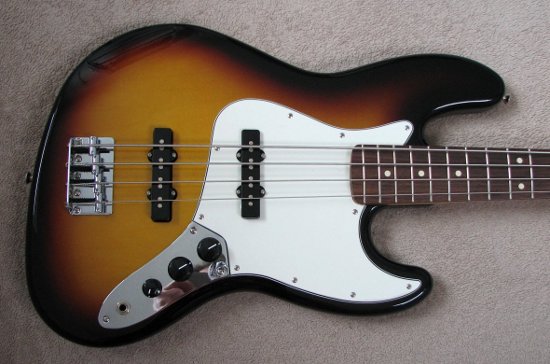The Musician's Room: Some Great Electric Guitars
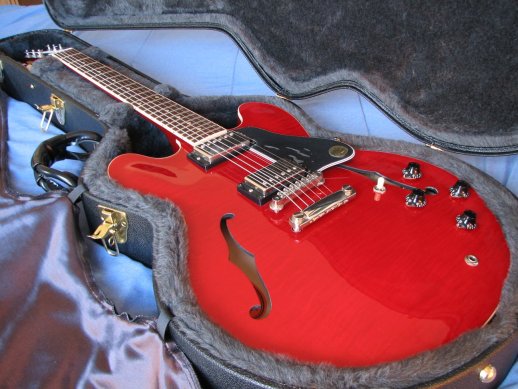 "Miss Right"
"Miss Right"
Here's a 2005 Gibson ES-335 Dot. After years of me wishing I could get some of those sweet, vintage, semi-hollow tones, my kind and sweet wife surprised me with this beauty for Christmas. To me, they are both "Miss Right." This guitar has got that woody, airy ES sound: The sweet neck pickup and the jangly bridge pickup with just the right amount of body sound mixed in. I was drawn to this one by its sound, from among about six or seven. I keep thinking, "So this is where those classic tones came from." It's a real bonus that it is visually pretty as well, with a subtle flamey maple all the way around. Kenny Marshall set up this guitar for me, and it feels great. It began with frets as high as .057(!) but they are now around .053 and I love that. The guitar features Grover tuners, nickel hardware, and a "1960s slim-taper neck." Gibson has gotten back to some nice building practices and here is the result. This one has become my favorite recording instrument and my home base. More Pictures and A Review
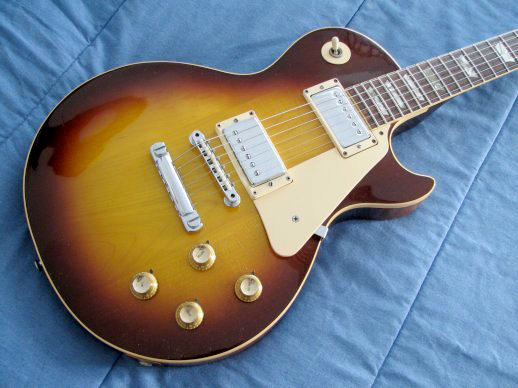 "Pauly"
"Pauly"
An Aussie friend gave this guitar its name in 1978. Here's my Gibson Les Paul Standard which dates from 1974 and was built at the old Gibson plant in Kalamazoo, Michigan. The body and neck construction, knobs, bridge, tuners and other characteristics and appointments of this instrument date it to anywhere from 1969 to 1974 but the pots dial it in. One thing is clear, however, it was not part of the "Standard" series which began production in Nashville in 1976. Only 2218 of these were made and most were special orders. It has what a Gibson employee from the period called a "Dark Wineburst" finish - a wine red color goes right out to the edge. The back and sides of the body and neck are also finished in this sunburst. Though it's not a very collectable LP, I've played and loved it since 1977 and it carries lots of memories. I saved for this guitar for three years and still couldn't affort it. A dealer took pity on me and sold it to me with a Univox case to bring down the price. In 1998, after it had seen a lot of miles and smiles, Kenny Marshall, my excellent luthier, planed the fretboard and refretted Pauly. We settled on .046 frets, a little taller than the standard Gibson fare. The result of his work is simply marvelous! The frets offer greater security in bends and a more settled feel in general. I recently tracked down an authentic 1974 Gibson case for it to live in. There are more pics of the guitar, HERE.
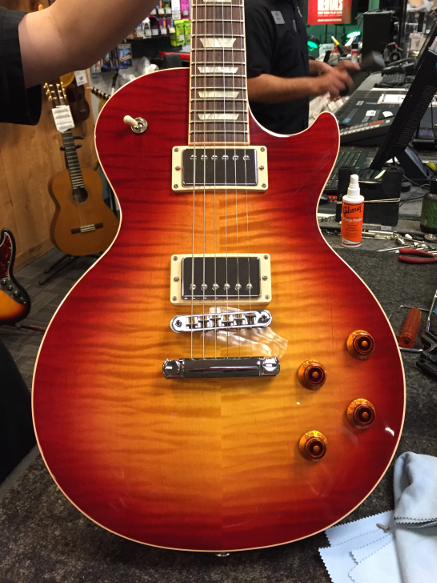 Goldilocks Syndrome
Goldilocks Syndrome
Pauly is a great guitar, but those '70s LPs are heavy and a sound a bit "harder" than either classic or modern Les Pauls. I'd wanted a lighter, sweeter Les Paul for years before I came across this one. To be honest, I really wasn't out looking for this 2018 Les Paul Standard but apparently it was looking for me. Perhaps with its subtle coaxing, I stumbled across this guitar high up on a guitar store's wall while I was trying out Les Paul Traditional Models. My eye was caught by the flamey top. I've never had an LP with much of a flamey top until this one and I think and this one has just enough flame for me. I feel like a guitar can have too little or too much figure, you know... Goldilocks syndrome. That might even be a nice name, eh? This one had only left the factory a month before. The body features Gibson's "Ultra-Modern Weight relief," bringing the overall weight down to seven pounds, eight ounces. That's two pounds less than Pauly. The neck features Gibson's "Assymetrical Slim Taper" and the frets are cryogenically treated for longevity. The pickups are "Burstbuckers," a development of Gibson's '57 Classics. The guitar offers four extra switching capabilities via push-pull pots: individual coil taps, an out-of-phase position, and a "blower" switch that selects the bridge pickup and bypasses (blows by) the tone pot. With all the switches depressed, the sound is just like, um, a Les Paul should be. Les Pauls Standards are shipped with the "poker chip" selector switch washer and the pickguard tucked into the neck box of the case. Now to decide whether or not to mount them. I shot this pic in the store, the night before the guitar followed me home. More pictures, HERE and review HERE.
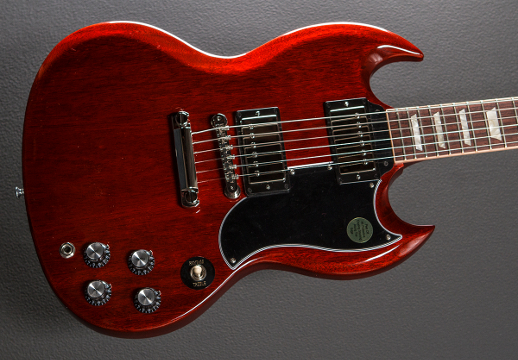 That Other Gibson Les Paul
That Other Gibson Les Paul
After some thirty-seven years of playing I've finally gotten around to connecting with a Gibson SG. This one is one of a 2016 limited edition commissioned by Dave's Guitar Shop of LaCrosse, WI, and Sweetwater. When Gibson discontinued their SG Standard '61 reissue in 2013, Dave's and Sweetwater saw demand for a really accurate reissue. They spec'd it with '57 Classic (neck) and '57 Classic Plus (bridge) pickups, an ABR-1 bridge, Kluson tuners with keystone keys, slim taper neck, a bound rosewood fingerboard, jumbo frets, trapezoidal inlays, a small "angel wing" pickguard, black reflector knobs, and nickel hardware. The sound is a bit slimmer and brighter than that of a Les Paul with a maple cap but that means you don't have to roll out as much bass for rhythm parts. The pickups give it a smooth sound and great articulation. I had just had a couple of used 2005 SG Standard '61 Reissues bought out from under me in a period of a week and a half when at last I found this one, the last of the limited run, at Dave's Guitar shop. On the advice of my wife I snapped it up in a hurry. It's the only guitar I've ever bought from the driver's seat of my car. More, HERE.
 The "Latest Greatest" Strat
The "Latest Greatest" Strat
Here is a 1999 G&L S-500. The small G&L company was Leo Fender's last venture before his death and the place where he felt he was really able to update his older designs, tweak them to perfection, and have them built by hand. The current G&L S-500 is just that: a hand-built update of the Fender Stratocaster featuring high-output ceramic pickups. G&L's Strat-types can be ordered with a hard-tail or Leo's excellent "Dual Fulcrum" tremolo tailpiece, which appears to be Leo's take on the Wilkinson unit. To my hands, G&Ls just feel more solid than most Fenders I've tried. With the "shouldering" of the neck being more rounded than a Fender's and thus more "C" shaped, it is very comfortable.
The guitar's circuitry offers their "Passive Bass and Treble" tone controls and an "expander" switch which allows all possible pickup combinations. Between the tone controls and the Magnetic Field Design pickups, you can move between a Strat sound and a fuller sound somewhat nearer to humbuckers. This particular guitar features a Louisiana Swamp Ash body, a lightly-figured birdseye maple neck, and a white pearloid pickguard. My lovely wife had this one built to order for me and my sons recently sent it to luthier Kenny Marshall for his special action treatment. Kenny worked it into really fine shape and it has since appeared on several album and soundtrack recordings.
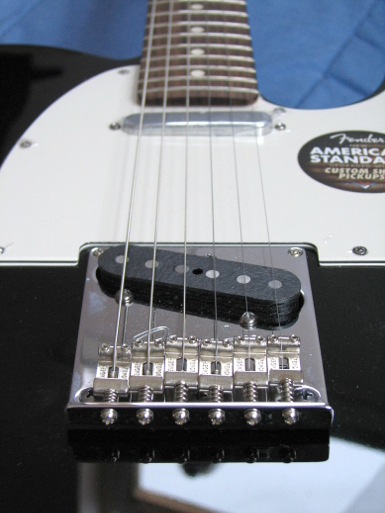 A Subtle Surprise
A Subtle SurpriseI know, I know. I'm a perennial late adopter, but there it is. I hail from the heart of country music but I never wanted to be a country musician. As a result, I resisted Telecasters for YEARS. However, the type finally tracked me down after I saw David Gilmour use one pretty extensively. Here is a 2013 American Standard Telecaster. The body is alder and the 9.5" radius fingerboard is rosewood. Once again the fingerboard edges are hand-rolled for smoothness. It offers a Custom Shop "Broadcaster" bridge pickup and a CS "Twisted Tele" neck pickup and the no-load Delta Tone Control. I discovered that I didn't favor the ash/maple combination for a Tele - it was just too country for mountain-bred me! This particular example does the bright chimey stuff with the tone control open but becomes a great blues/rock guitar when you pull back on the tone control. I'd always played Teles wide open and never thought they would be worth much that way but experimenting with the volume and tone controls opened an entirely new world of sounds to me. It was literally another case of "less is more." In the end, I discovered that I was more comfortable with a Tele than a Strat. Surprise! I've found that this Tele loves most of my tube amps and has fitted really nicely into my studio rig as well. This guitar has also figured into many recordings I've played on. You can see what I found HERE .
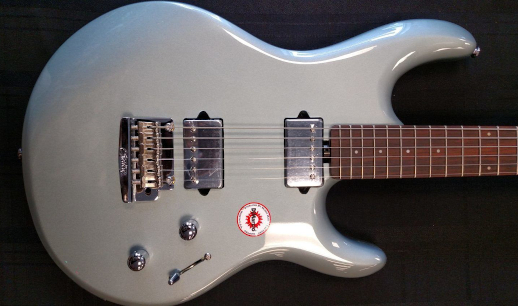 Six-Hundred Thirteen Pounds Sterling
Six-Hundred Thirteen Pounds SterlingI'm not much into signature model guitars but after watching Steve Lukather play live and on the 35th Anniversary: Live in Poland video I became intrigued with Steve's guitar design. Here is a 2018 MusicMan Sterling LK100D Steve Lukather signature model. The body is basswood and slightly smaller than a Strat, the neck is hard maple, and the fingerboard is rosewood. The "D"in the model name refers to Steve's signture DiMarzio Transition pickups that the guitar carries. There's a unique five-way switching pattern that splits the pickup coils in the two and four position, and a twelve db boost available via a push-push volume pot. The smaller 4+2 headstock reduces the string resistance in bends and the vintage trem offers flexibility. A narrow 1.65" nut width makes reaching stretched fingerings easier for my short fingers. This year (2019) Sterling decided to drop the model into a lower price range and did so by replacing the DiMarzios with pickups that many feel aren't nearly as good and renamed it the "LUKE." All-in-all this package makes for a tremendous lead guitar vehicle. I tracked down one of the last new LK100Ds on the continent and had it shipped to the Musician's Room world headquarters. Marvelous! You can read my review, HERE .
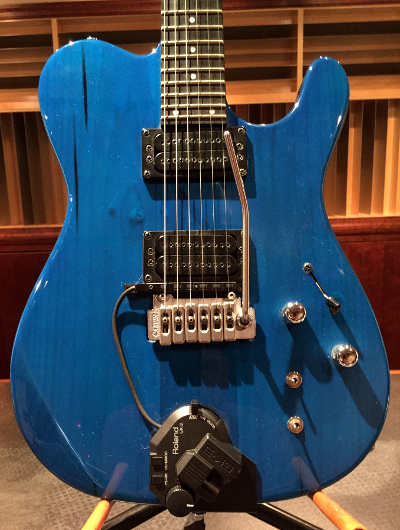
Swiss Army Electric
I would never have bought one of these mail order but I ran into this one used at a local shop and was thoroughly impressed. I call this my "Swiss Army Electric," and I'll tell you why later.
Standard Carvins (now "Kiesels") come with neck-though-body construction which allows them to have the smoothest neck heel in the business. They have a 1 3/4" fingerboard width and a twenty-five inch scale. The neck features twenty-four medium jumbo frets and can be adjusted to allow an extremely low action. I actually had to raise the action of this guitar to comfortably allow bends. The guitar's fit and finish is superb, as is its fret work and set up. This particular model is a circa 1994 Carvin TL60T, with the "TL" designating a Tele shape and the final "T" designating that the guitar has the Wilkinson tremolo system. The Wilkinson trem is a floating trem which, when coupled with the guitar's Sperzel locking tuners, offers really smooth, in-tune tremolo. The guitar features two splitable humbucking pickups, a maple neck with an ebony fingerboard, and alder body "wings." The wood combination and pickups make for a fairly bright, clean, and extremely powerful sound. The guitar has excellent individual-string definition. When run clean, I call it a "technical" sound.
Why do I call it my "Swiss Army Guitar?" Mainly because it is very flexible, due to the splittable 'buckers and the excellent high-end fret access. I am able to get all kinds of sounds, from high-gain 'bucker full to bright and pingy single coil. It is also robust, and has performed flawlessly through lots and lots of gigs. I keep it at the studio with the Roland synth pickup attached.
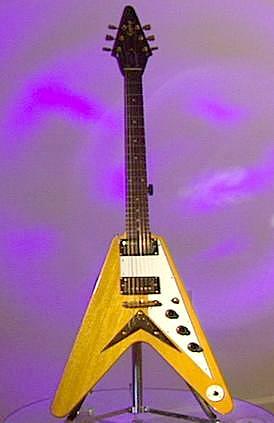
Whose Guitar is it Today?
This is an Epiphone reissue of a '58 Gibson Korina Flying V. "Korina" is Gibson's name for African Limba, a relative of Mahogany. While I prefer the looks and sound of the second generation, mahogany '67 Gibson 'Vs, this design comes pretty close. The "V" has a unique, spanky sound with less low middle than a Les Paul.
Though I bought a Korina Explorer for my son as a Christmas and this guitar for myself and "dad and lad" thing, in 1999. A few years ago when I needed money for Christmas and decided to sell it, my son stepped in and bought it from me to keep the two together. A year later, I had the distinct pleasure of buying it back from him when he needed money to buy an engagement ring for his girl. Within a week I played it at a gig! I set it up with medium strings and a high action for slide chores and performs well in that role. I love the "ooohs" and "ahs" I hear when I pull out this guitar.
This photo is a still of a video frame from a TV shoot in 2000. While I live in blissful obscurity, this guitar has been featured as the main set piece on a television show seen 'round the world! As always, it made a distinct impression. My son began pining for it again a couple of years later, so it went back to him. Later, we installed a pair of Seymour Duncan humbuckers in it and it now sounds like a million dollars. More about that, HERE
Sadly, with the passing of my son, the guitar has come back to me again under the worst possible circumstances. You can read about that, HERE
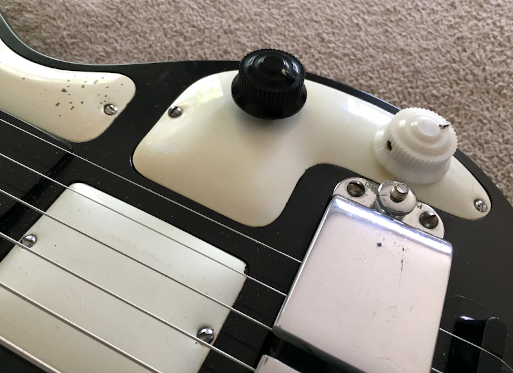
Bob Gets the Bear
This is a wartime Rickenbacher Model B. Yes, a "Rickenbacher." The whole family changed spelling to "Rickenbacker" with a "K" after WWII. Ricks are a bit hard to nail down to an exact age, but this one appears to be from about 1939 to 1942. I've wanted one of these for years and years and with the help of a couple of new friends and my wife I finally tracked this one down. The wartime Ricks had the desirable horseshoe pickup of the more collectable pre-war models but added several innovations that improved them, such as a reformulated Bakelite composition that prevented chips and cracks, a strengthened neck, a tone control, having the output jeck moved to the audience side, and white-painted lines surrounding the frets for better visibility on dark stages During this time they also changed the body panels from chrome to white, earning the guitar its nickname, "Panda." The sound of the prewar and wartime Rick Model B guitars is legendary. Between the Bakelite body and the powerful pickup it offers a gentle attack followed by a bold, strong sustain phase and a nice round midrange. Pics from the unboxing can be found HERE and the story of stalking the Panda in the wild can be found HERE.
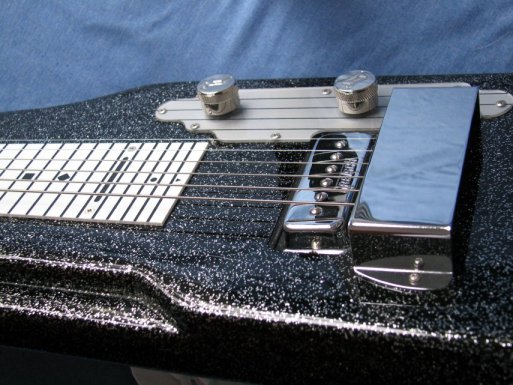
 How They Did It Back When...
How They Did It Back When...